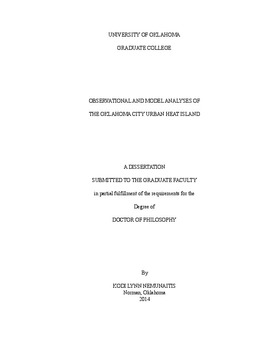| dc.description.abstract | To date, much of the current understanding of the impacts of urban areas on atmospheric processes results from a number of field programs. Between 28 June and 31 July 2003, a vast array of instrument systems collected high-resolution observations of meteorological variables in and around Oklahoma City during Joint Urban 2003, the largest urban dispersion field experiment to date. The data collected from the field measurements, combined with data collected from existing atmospheric observing systems in central Oklahoma presented a unique opportunity to investigate the urban heat island of Oklahoma City.
As numerical weather prediction models continue to evolve toward finer grid spacing, it becomes increasingly important to properly represent urban effects in land surface, surface layer, and PBL schemes. Recent efforts have been undertaken to “urbanize” numerical weather prediction and climate models. One common approach is to couple an urban canopy model with a land surface model.
For this study, the single-layer urban canopy model in the High-Resolution Land Data Assimilation System (HRLDAS) and Advanced Research Weather Research and Forecasting (ARW-WRF) modeling systems were used to investigate the sensitivity of near-surface air temperatures and energy fluxes to urban canopy parameters in uncoupled (land) and coupled (land-atmosphere) predictions. The model results were compared with observations collected by the Oklahoma Mesonet and Joint Urban 2003 collaborators.
While the components of the surface energy balance were sensitive to albedo and thermal conductivity of the urban roof surface, and to the fraction of the grid cell that was impervious, near-surface air temperatures, particularly during the daytime, did not show significant variations with urban parameters. The sensitivity of near-surface temperatures to urban canopy parameters depended on the method used to calculate the skin temperature of the impervious surface. | en_US |
